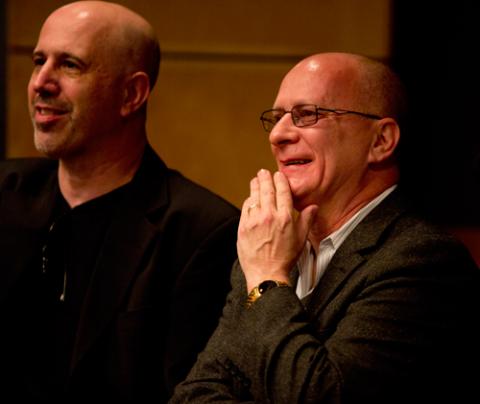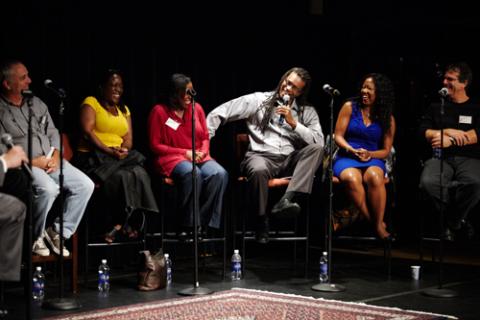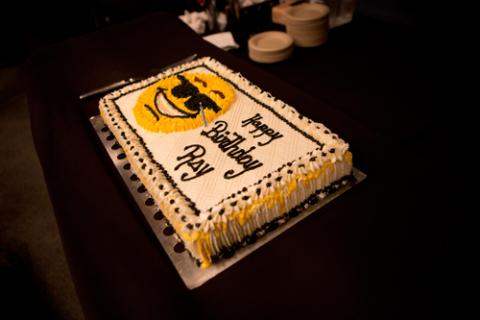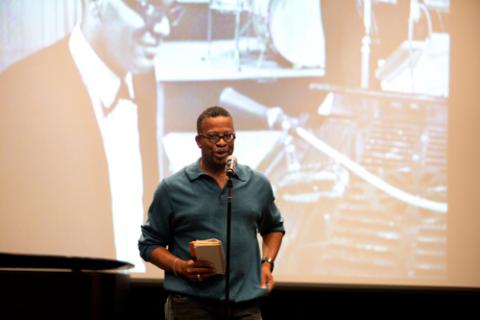Working with Ray Charles

Matt Glaser (left), artistic director for the American Roots Program and Inspired by Ray event producer, with Tony Gumina, president of the Ray Charles Marketing Group
Photo by Kelly Davidson

Panelists for the Working with Ray event, from left: Victor Vanacore, Tonette McKinney, Renee Georges, DuPor Georges, Katrina Harper, and Curt Sobel.
Photo by Dave Green

The Inspired by Ray Symposium closed with an event on what would have marked Ray Charles's 82nd birthday.
Photo by Kelly Davidson

Professor Bill Banfield, director of Berklee's Africana Studies, a discipline within the Liberal Arts Department.
Photo by Kelly Davidson
From stories from the road, the recording studio, the business table—all prisms through which to learn about Ray Charles—there emerged a picture of a man known for his personalized approach, sense of humor, and above all else, his commitment to the music.
On stage at David Friend Recital Hall Saturday, the 10 panelists’ associations with Charles ran deep and spanned the music icon’s illustrious career; they included members of the backing vocals group the Raeletts, his cowriter on “I Got a Woman,” a drummer, trumpet player, his musical director and arranger, and the music editor and music supervisor for the 2004 biopic Ray. The panel, entitled Working with Ray, was part of a three-day symposium—Inspired by Ray—hosted by Berklee’s American Roots Music Program that was capped with a tribute concert marked with novel arrangements of Charles’s work.
The following are threads of that conversation, which was moderated by Tony Gumina, president of the Cleveland-based Ray Charles Marketing Group.
Renald Richard, trumpet player for the Ray Charles band, cowriter on “I Got a Woman”
“We were traveling in Indiana, around South Bend. Ray loved to listen to gospel music, especially after a gig. A song by the Southern Tones came on” and this served as the inspiration for the song. After working some of it out, “Ray said, ‘You think you can do something with that?’ . . . I didn’t go to bed. The next morning I had the lyrics.”
Peter Turre, drummer and musical director for Ray Charles
“He was the best band leader I’ve ever worked with in terms of explaining what he wanted.”
Victor Vanacore ’74, Ray Charles’s musical director, arranger, and opening act
“I took six to seven semesters of conducting at Berklee. I always knew one day I’d use it. My career didn’t synthesize until I got to Ray.”
Tonette McKinney, member of the Raeletts
“My friend was supposed to get the gig but her husband wouldn’t allow her to travel. She said ‘You do it.’ So I sent in a tape and I got a call from Ray Charles. I almost lost it. He asked if I could come in and audition. I did “What a Difference a Day Makes.” After he said, ‘Well, we’re going to London Saturday. Are you going?’ I said, ‘Yeah, I’m going!’ When I was 7 years old we got three channels. Every night, Channel 12 played “America the Beautiful” by Ray Charles. My mother let me stay up and listen every night. I had the opportunity to stay up, not knowing in my lifetime I’d actually be a part of that someday. . . To be blessed to actually have been a part of what I admired as a little girl, today I’m still in awe.”
Curt Sobel ’78, music supervisor and music editor for the film Ray
“It was remarkable for me to be a part of this. . . I thought it would be cool to shoot (the sessions prior to our pre-records and the pre-recording sessions) with a digital camera and then make a DVD for Jamie (Foxx). . . He’s a wonderful piano player but classically trained. He needed to make the transition to the jazz world. . . In preparing for today I looked back at the tapes and I had about 11 hours of footage. . . I was nervous and excited and it was really electrifying to be in the room, to watch Jamie become Ray and move with him. They sat side by side on two piano benches. . . I’m standing behind them with a digital camera and they’re laying down the first tracks. Ray is playing and singing. Taylor is standing next to me and I’m shooting Ray’s hands. All of a sudden it hits me—this goes back to the training I had here at Berklee in the film department and also my work in the industry—that you can’t sing and play at the same time. It won’t be useful for the film for many reasons. I elbowed (director) Taylor (Hackford) and said: ‘Ray can’t sing and play at the same time.’ The piano mic picked it up and Ray heard me,” and mistakenly thought he was saying that he wasn’t capable of singing and playing at the same time. Sobel said he went onto explain, point by point, that he needed separate footage of Ray playing and singing.
